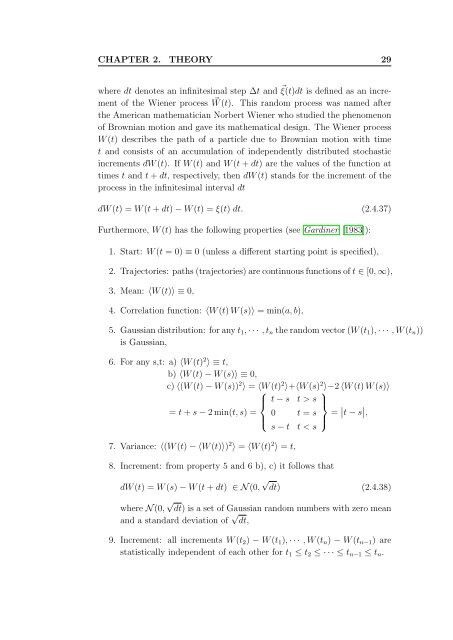Three-dimensional Lagrangian Tracer Modelling in Wadden Sea ...
Three-dimensional Lagrangian Tracer Modelling in Wadden Sea ...
Three-dimensional Lagrangian Tracer Modelling in Wadden Sea ...
You also want an ePaper? Increase the reach of your titles
YUMPU automatically turns print PDFs into web optimized ePapers that Google loves.
CHAPTER 2. THEORY 29<br />
where dt denotes an <strong>in</strong>f<strong>in</strong>itesimal step ∆t and � ξ(t)dt is def<strong>in</strong>ed as an <strong>in</strong>crement<br />
of the Wiener process � W (t). This random process was named after<br />
the American mathematician Norbert Wiener who studied the phenomenon<br />
of Brownian motion and gave its mathematical design. The Wiener process<br />
W (t) describes the path of a particle due to Brownian motion with time<br />
t and consists of an accumulation of <strong>in</strong>dependently distributed stochastic<br />
<strong>in</strong>crements dW (t). If W (t) and W (t + dt) are the values of the function at<br />
times t and t + dt, respectively, then dW (t) stands for the <strong>in</strong>crement of the<br />
process <strong>in</strong> the <strong>in</strong>f<strong>in</strong>itesimal <strong>in</strong>terval dt<br />
dW (t) = W (t + dt) − W (t) = ξ(t) dt. (2.4.37)<br />
Furthermore, W (t) has the follow<strong>in</strong>g properties (see Gard<strong>in</strong>er [1983]):<br />
1. Start: W (t = 0) ≡ 0 (unless a different start<strong>in</strong>g po<strong>in</strong>t is specified),<br />
2. Trajectories: paths (trajectories) are cont<strong>in</strong>uous functions of t ∈ [0, ∞),<br />
3. Mean: 〈W (t)〉 ≡ 0,<br />
4. Correlation function: 〈W (t) W (s)〉 = m<strong>in</strong>(a, b),<br />
5. Gaussian distribution: for any t1, · · · , tn the random vector (W (t1), · · · , W (tn))<br />
is Gaussian,<br />
6. For any s,t: a) 〈W (t) 2 〉 ≡ t,<br />
b) 〈W (t) − W (s)〉 ≡ 0,<br />
c) 〈(W (t) − W (s)) 2 〉 = 〈W (t) 2 〉+〈W (s) 2 〉−2 〈W (t) W (s)〉<br />
⎧<br />
⎫<br />
⎪⎨ t − s t > s ⎪⎬<br />
= t + s − 2 m<strong>in</strong>(t, s) = 0 t = s<br />
⎪⎩<br />
⎪⎭<br />
s − t t < s<br />
= � �<br />
�t − s�, 7. Variance: 〈(W (t) − 〈W (t)〉) 2 〉 = 〈W (t) 2 〉 = t,<br />
8. Increment: from property 5 and 6 b), c) it follows that<br />
dW (t) = W (s) − W (t + dt) ∈ N (0, √ dt) (2.4.38)<br />
where N (0, √ dt) is a set of Gaussian random numbers with zero mean<br />
and a standard deviation of √ dt,<br />
9. Increment: all <strong>in</strong>crements W (t2) − W (t1), · · · , W (tn) − W (tn−1) are<br />
statistically <strong>in</strong>dependent of each other for t1 ≤ t2 ≤ · · · ≤ tn−1 ≤ tn.

















